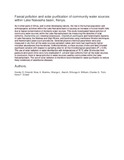Faecal pollution and solar purification of community water sources within Lake Naivasha basin, Kenya.
Date
2013-04-03Author
Omondi, Donde O.
Wairimu, Muia A.
Aketch, Wanga L.
William, Shivoga A.
Trick, Charles G.
Creed, Irena F.
Metadata
Show full item recordAbstract
As in other parts of Africa, and in other developing nations, the rise in the human population and anthropogenic activities within the Lake Naivasha basin is causing an increase in human health risks due to faecal contamination of domestic water sources. This study investigated faecal pollution of community water sources within the Lake Naivasha basin by measuring the densities of total coliforms, Escherichia coli, intestinal enterococci, Clostridium perfringens and heterotrophic bacteria in Lake Naivasha, the Malewa and Gilgil Rivers, and boreholes using membrane filtration techniques and heterotrophic plate count procedures. Selected physico-chemical parameters were also measured in situ from all the water sources sampled. Lakes and rivers had significantly higher microbial abundances than boreholes. Unlike boreholes, surface sources (rivers and lake) showed significant variation with respect to sampling sites for all the microbiological parameters (P < 0.05). The use of solar radiation in water disinfection with temperatures of 75 °C after 30 minutes from pasteurization point (time zero) fully eradicated E. coli and total coliforms from all the water sources. In conclusion, there is faecal pollution in water sources used by communities within the Lake Naivasha basin. The use of solar radiation is therefore recommended for water purification to reduce likely incidences of waterborne diseases.
URI
https://doi.org/10.2166/washdev.2015.150https://iwaponline.com/washdev/article-abstract/5/2/252/30100/Faecal-pollution-and-solar-purification-of?redirectedFrom=fulltext
http://r-library.mmust.ac.ke/123456789/1761
Collections
- Gold Collection [1026]

